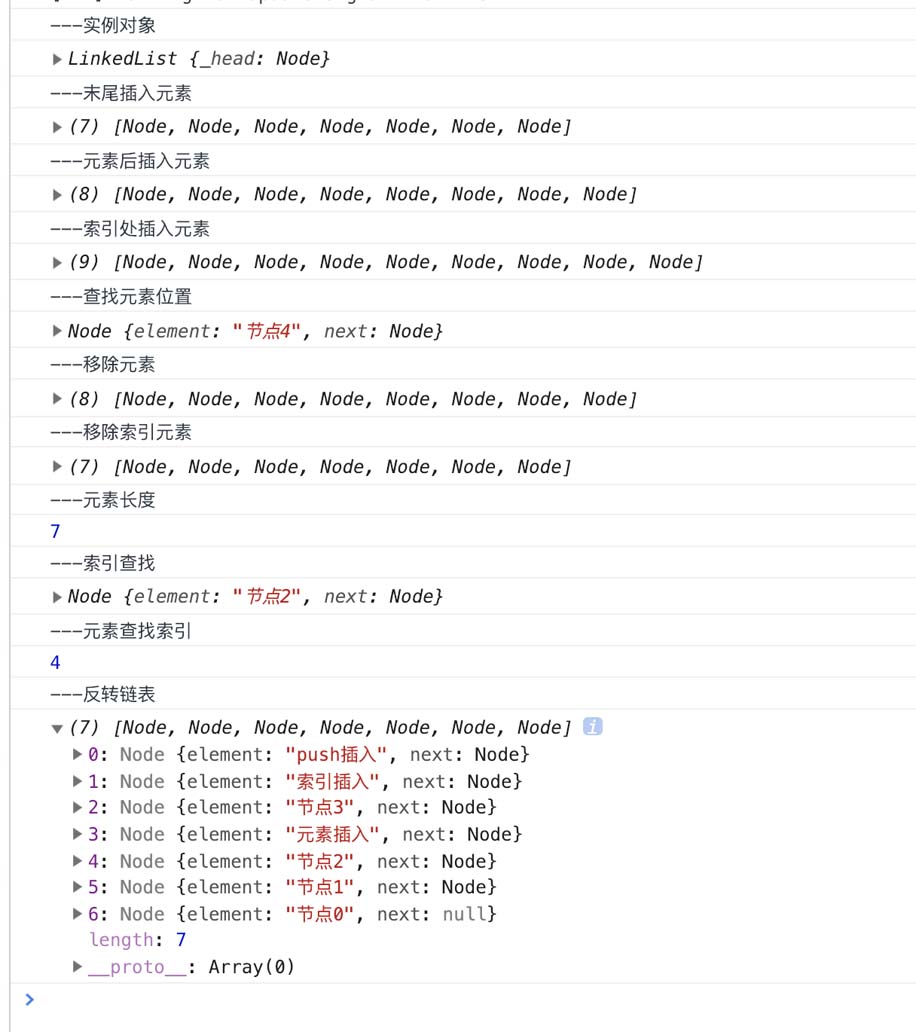前言
前端也要搞好数据结构哦!
用JavaScript实现了个单链表,通过LinkedList构造函数可实例化一个单链表数据结构的对象,所有的方法放到LinkedList构造函数的原型对象上,写了暂时能想到的所有方法
实现
方法介绍
查找
obj.find(item)通过item元素内容查找到该元素obj.findIndex(index)通过index索引查找到该元素obj.findIndexOf(item)通过item元素内容查找到该元素索引obj.findPrev(item)通过item元素查找上一个节点元素添加
obj.insert(item,newElement)在item元素后插入新元素obj.push(item)在链表末尾插入item元素obj.insertIndex(index,newElement)在index索引处插入新元素删除
obj.remove(item)删除item元素obj.removeIndex(index)删除index索引处节点其他
obj.size()返回该链表的长度obj.display()数组形式返回该链表,便于观察,测试obj.reversal()链表顺序反转(递归)方法代码
链表类LinkedList
function LinkedList (...rest) {
this._head = new Node('_head') // 链表头节点
// 如果new时有传进值,则添加到实例中
if (rest.length) {
this.insert(rest[0], '_head')
for (let i = 1; i < rest.length; i++) {
this.insert(rest[i], rest[i - 1])
}
}
}
LinkedList.prototype.find = find
LinkedList.prototype.findPrev = findPrev
LinkedList.prototype.findIndex = findIndex
LinkedList.prototype.findIndexOf = findIndexOf
LinkedList.prototype.push = push
LinkedList.prototype.insert = insert
LinkedList.prototype.insertIndex = insertIndex
LinkedList.prototype.remove = remove
LinkedList.prototype.removeIndex = removeIndex
LinkedList.prototype.size = size
LinkedList.prototype.display = display
LinkedList.prototype.reversal = reversal
创建新节点类Node
function Node (element) {
this.element = element
this.next = null
}
obj.find(item)
// 查找函数,在链表中查找item的位置,并把它返回,未找到返回-1
function find (item) {
let currNode = this._head
while (currNode !== null && currNode.element !== item) {
currNode = currNode.next
}
if (currNode !== null) {
return currNode
} else {
return null
}
}
obj.findIndex(index)
// 通过元素的索引返回该元素
function findIndex (index) {
let currNode = this._head
let tmpIndex = 0
while (currNode !== null) {
// 找到该index位置,返回当前节点,出去头结点
if (tmpIndex === index + 1) {
return currNode
}
tmpIndex += 1
currNode = currNode.next
}
return null
}
obj.findIndexOf(item)
function findIndexOf (item) {
let currNode = this._head
let tmpIndex = 0
while (currNode.next !== null && currNode.next.element !== item) {
tmpIndex += 1
currNode = currNode.next
}
if (currNode !== null) {
return tmpIndex
} else {
return -1
}
}
obj.findPrev(item)
// 寻找目标节点item的上一个节点,未找到返回-1
function findPrev (item) {
let currNode = this._head
while (currNode.next !== null && currNode.next.element !== item) {
currNode = currNode.next
}
if (currNode.next !== item) {
return currNode
} else {
return null
}
}
obj.insert(item,newElement)
// 插入节点,找到要插入到的item的节点位置,把新节点插到item后面
function insert (newElement, item) {
let newNode = new Node(newElement)
let currNode = this.find(item)
if (currNode) {
newNode.next = currNode.next
currNode.next = newNode
} else {
console.error(`insert error:链表中不存在「${item}」节点`)
}
}
obj.insertIndex(index,newElement)
// 插入节点,新节点插到index索引下
function insertIndex (newElement, index) {
let newNode = new Node(newElement)
let currNode = this.findIndex(index)
if (currNode) {
newNode.next = currNode.next
currNode.next = newNode
} else {
console.error(`insertIndex error:链表中不存在「${index}」索引节点`)
}
}
obj.push(item)
// 在链表最后一位添加元素
function push (element) {
let newNode = new Node(element)
let currNode = this._head
while (currNode.next !== null) {
currNode = currNode.next
}
currNode.next = newNode
}
obj.remove(item)
// 删除节点,找到删除的位置,删除,未找到提示错误
function remove (item) {
// 找到当前和上一个节点,让上一个节点的next指向item下一个节点
let tmpPrev = this.findPrev(item)
let tmpNext = this.find(item)
if (tmpPrev && tmpNext) {
tmpPrev.next = tmpNext.next
} else {
console.error(`remove error:链表中不存在「${item}」节点`)
}
}
obj.removeIndex(index)
// 删除某个索引下的节点
function removeIndex (index) {
let tmpPrev = this.findIndex(index - 1)
let currNode = this.findIndex(index)
if (tmpPrev && currNode) {
tmpPrev.next = currNode.next
} else {
console.error(`removeIndex error:链表中不存在「${index}」索引节点`)
}
}
obj.size()
function size () {
let currNode = this._head
let tmpSize = 0
while (currNode.next !== null) {
tmpSize += 1
currNode = currNode.next
}
return tmpSize // 不计算头部节点
}
obj.reversal()
// 链表反转=>递归
function reversal () {
function reversalList (item) {
if (item.next) {
let tmpItem = reversalList(item.next)
item.next = null
tmpItem.next = item
return item
} else {
obj._head.next = item
return item
}
}
reversalList(obj._head.next)
}
obj.display()
function display () {
// 链表展示和使用,默认头部不存在
let currNode = this._head.next
let tmpArr = []
while (currNode !== null) {
tmpArr.push(currNode)
currNode = currNode.next
}
return tmpArr
}
实例测试
// 运行测试
let obj = new LinkedList('节点0', '节点1', '节点2', '节点3', '节点4', '节点5')
console.log('---实例对象')
console.log(obj)
console.log('---末尾插入元素')
obj.push('push插入')
console.log(obj.display())
console.log('---元素后插入元素')
obj.insert('元素插入', '节点2')
console.log(obj.display())
console.log('---索引处插入元素')
obj.insertIndex('索引插入', 5)
console.log(obj.display())
console.log('---查找元素位置')
console.log(obj.find('节点4'))
console.log('---移除元素')
obj.remove('节点5')
console.log(obj.display())
console.log('---移除索引元素')
obj.removeIndex(5)
console.log(obj.display())
console.log('---元素长度')
console.log(obj.size())
console.log('---索引查找')
console.log(obj.findIndex(2))
console.log('---元素查找索引')
console.log(obj.findIndexOf('节点3'))
console.log('---反转链表')
obj.reversal()
console.log(obj.display())
测试结果

结尾
最近遇到单链表反转的问题,所有加了一个单链表反转的方法,用递归实现
相关链接
总结
以上就是这篇文章的全部内容了,希望本文的内容对大家的学习或者工作具有一定的参考学习价值,如果有疑问大家可以留言交流,谢谢大家对的支持。